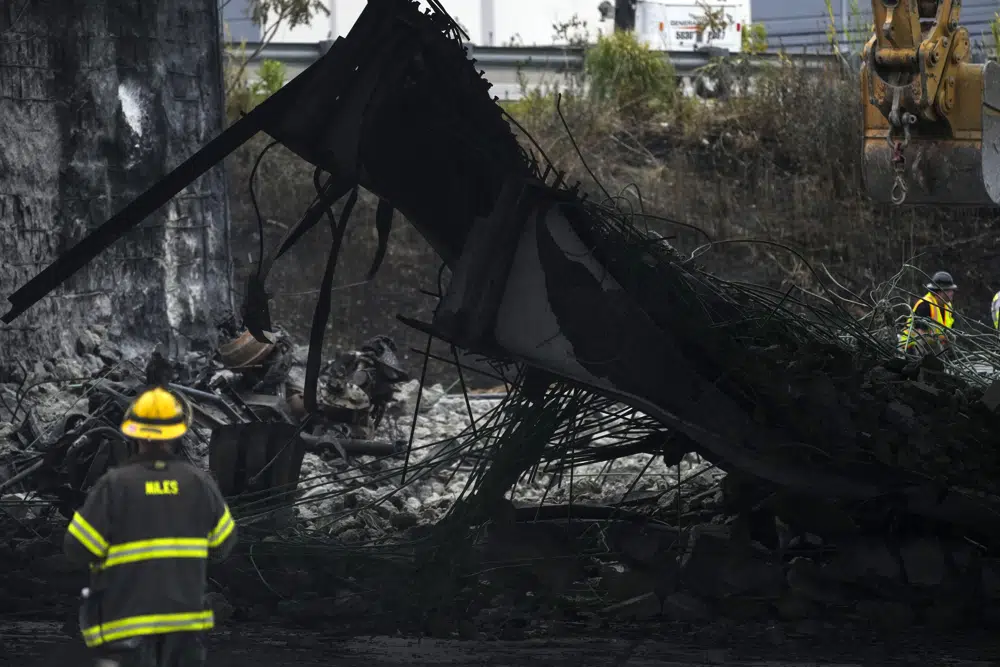State and federal investigators were trying to find out Monday why a tanker fire collapsed a section of the East Coast’s main north-south highway, throwing hundreds of thousands of morning commutes into chaos and disrupting commerce for untold numbers of businesses.
Interstate 95 will be closed in both directions for weeks at the start of summer travel season. Motorists should expect extensive delays and street closures, and avoid the northeast corner of the sixth-largest city in the country, transportation officials said.
The accident also disrupted the car route from Canada to Florida through the Boston, New York and Washington metropolitan areas, increasing Americans’ dependence on air travel and the interstate rail network.
Pennsylvania Transportation Secretary Michael Carroll said the I-95 segment carries roughly 160,000 vehicles per day and was likely the busiest interstate in Pennsylvania.
Sunday morning’s fire sent plumes of black smoke into the air. The northbound lanes collapsed and the southbound counterparts were compromised, according to the Philadelphia Fire Department.
Authorities have not publicly identified the truck owner or the driver, indicated whether the driver survived or said what exactly fueled the blaze. A Pennsylvania State Police spokesperson said early Monday he had no information about those details and did not indicate when police might disclose more.
Gov. Josh Shapiro signed a disaster declaration Monday, saying it gives state agencies the ability to skip normal bidding and contracting requirements so that the span can be repaired more quickly. The declaration lasts for 21 days, unless lawmakers agree to extend it. Shapiro said Sunday that no motorists on the highway were injured or died, although videos shared on social media showed some close calls, with people driving through as flames licked upward from the fire below.
AAA spokesperson Jana Tidwell warned of a congestion “ripple effect” and that the closure could also mean drivers will incur more costs — like wear and tear on their cars, more tolls and gas — as they navigate detours.
Officials said the tanker contained a petroleum product that may have been hundreds of gallons (liters) of gasoline. The fire took about an hour to get under control.
High heat from the fire or the impact of an explosion could have weakened the steel beams supporting the overpass, according to Drexel University structural engineering Professor Abi Aghayere. Bridges like the one that collapsed don’t typically have fire protection, like concrete casing, he added. It could have been coated in a fire-retarding paint, but even then the beams could have been weakened.
“It just gives you time,” he said.
Among many transportation changes across the region, the Southeastern Pennsylvania Transportation Authority said it was operating three extra morning and late afternoon trains on its Trenton, New Jersey, line, and adding capacity to regularly scheduled lines during peak hours following the collapse.
The collapsed section of I-95 was part of a $212 million reconstruction project that wrapped up four years ago, state Transportation Department spokesman Brad Rudolph said. PennDOT rated the 104-foot span as in “good” condition earlier this year, with another inspection set for 2025.
Shapiro, a Democrat, said he had been spoken directly to U.S. Transportation Secretary Pete Buttigieg and had been assured that there would be “absolutely no delay” in getting federal funds quickly to rebuild what he called a “critical roadway” as safely and efficiently as possible. Shapiro said the complete rebuild of I-95 would take “some number of months,” and in the meantime officials were looking at “interim solutions to reconnect I-95 and get traffic through the area.”
The National Transportation Safety Board said it was sending a team to investigate the fire and collapse.
Officials were also concerned about the environmental effects of runoff into the nearby Delaware River.
After a sheen was seen in the Delaware River near the collapse site, the Coast Guard deployed a boom to contain the material. Ensign Josh Ledoux said the tanker had a capacity of 8,500 gallons (32,176 liters), but the contents did not appear to be spreading into the environment.
The fire was strikingly similar to another blaze in Philadelphia in March 1996, when an illegal tire dump under I-95 caught fire, melting guard rails and buckling the pavement.
(AP)











